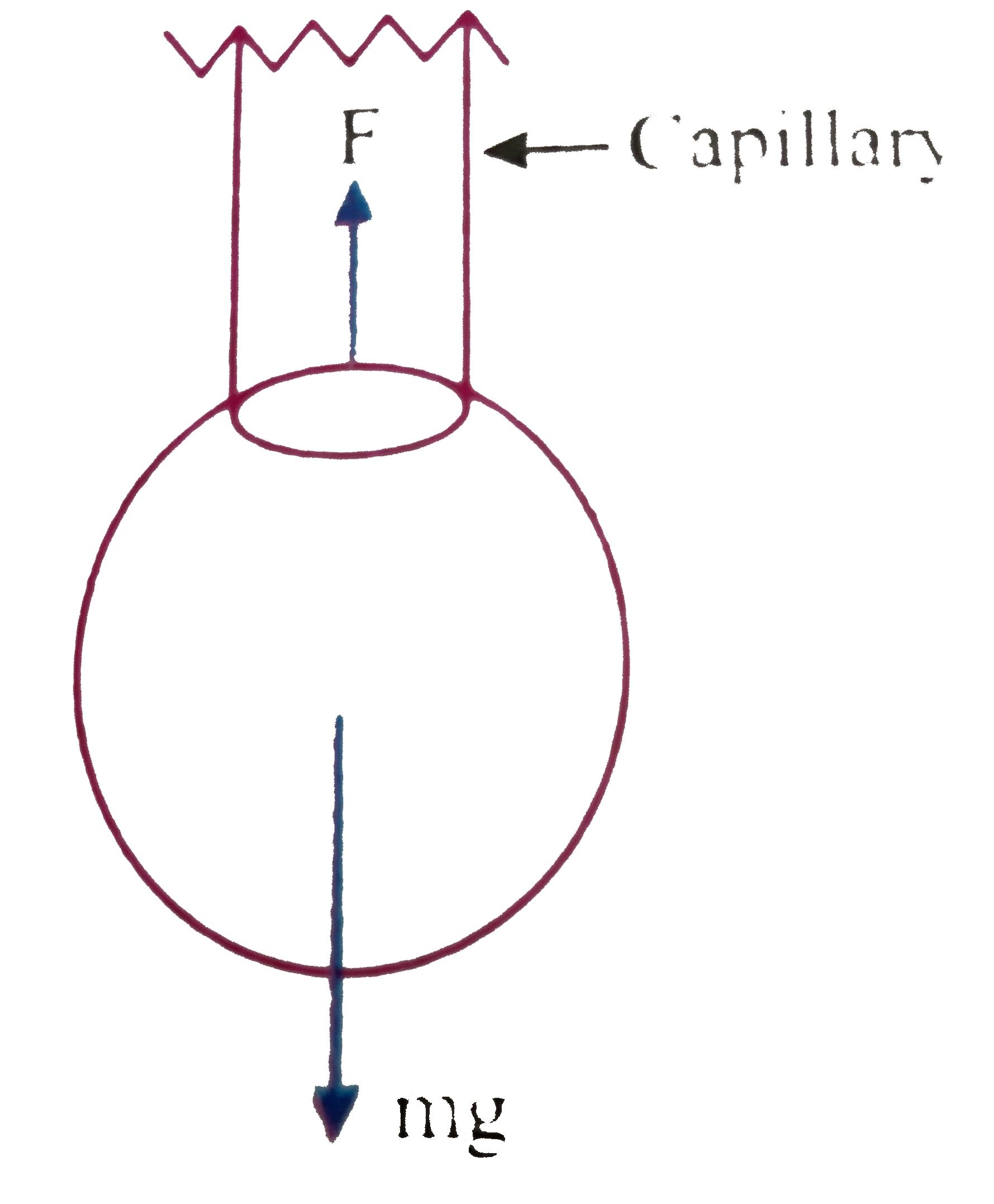Example from DHANPAT RAI & CO PHYSICS Chapter 10 Mechanical Properties of fluids for Class 11
| Class 11 | PHYSICS |
| Chapter | Mechanical Properties of fluids |
| DHANPAT RAI & CO PHYSICS | Example |
| Medium | English |
| Academic Year | 2023-2024 |
Question 15
Two syringes of different cross-sections (without needles) filled with water are connected with a tightly fitted rubber tube filled with water. Diameters of the smaller piston and larger piston are 1.0cm and 3.0 cm respectively.
(a) Find the force on the larger piston when a force of 10N is applied to the smaller piston.
(b) The smaller piston is paused in through 6.0 cm, much does the larger piston move out?View SolutionQuestion 16
Two syringes of different cross-section (without needle filled with water are connected with a tightly fitted rubber tube filled with water. Diameters of the smaller piston an larger piston are 1cm and 3cm respectively. If a force of 10N is applied to the smaller piston then the force exerted on the larger piston is View SolutionQuestion 28
A spring balance reads 10 kg when a bucket of water is suspended from it. What is the reading on the spring balance when (i) an ice cube of mass 1.5 kg is put into the bucket (ii) an iron piece of mass 7.8 kg suspended by another spring is immersed with half its volume inside the water n the bucket. Relative density of iron = 7.8View SolutionQuestion 29
A spring balance reads 10 kg when a bucket of water is suspended from it. What is the reading on the spring balance when (i) an ice cube of mass 1.5 kg is put into the bucket (ii) an iron piece of mass 7.8 kg suspended by another spring is immersed with half its volume inside the water n the bucket. Relative density of iron = 7.8View SolutionQuestion 33
A jeweller claims that he sells ornaments made of pure gold that has the relative density of 19.3.He sells a necklace weighing 25.250g f to a person. The clever customer weighs the necklace when immersed in pure water and finds that it weighs 23.075g f in water. Is the ornament made of pure gold?View SolutionQuestion 38
A flat plate of 20 cm squre moves over another similar plate with a thin layer of 0.4 cm of a liquid between them. If a force of one kg. wt. moves one of the plates uniformly with a velocity with a velcoity of 1ms−1 calculate the strain rate, sheraing stres and coefficient of viscosity.View SolutionQuestion 45
A capillary tube of 1mm diameter and 20 cm long is fitted horizontally to a vessel kept full of alcohol of density 0.8 gm//c.c. The depth of centre of capillary tube below the surface of alcohol is 20 cm. If the visosity of oil is 0.12dynecm−2 s, find the amount of liquid that will flow in 5 minuts. View SolutionQuestion 46
In giving a patient a blood transfusion, the bottle is set up so that the level of blood is 1.3 m above the needle, which has an internal diameter of 0.36 mm and 3 cm in length . If 4.5cm3 of blood passes through the meedle in one minute, calculate the viscosity of blood. The density of blood is 1020 kg m−3.View SolutionQuestion 48
Two tubes A and B of length 80 cm and 40 cm have radii 0.1 mm and 0.2 mm respectively are connected in series end to end. If a liquid passing through tow tubes is entering A at a pressure of 82 cm of mercury and leaving B at a pressure of 76 cm of mercury. Find the pressure at the junction of A and B.View SolutionQuestion 49
Two capillary tubes AB and BC are joined end to end at B, AB is 16cm long and of diameter 4mm whereas BC is 4cm long and of diameter 2mm. The composite tube is held horizontally with A connected to a vessel of water giving a constant head of 3cm and C is open to the air. Calculate the pressure difference between B and C.View SolutionQuestion 51
The level of liquid in a cylinderical vessel is kept constant at 30cm. It has three identical horizontal tubes of length 39cm, each coming out at heights 0,4 and 8cm respectively. Calculate the length of a single overflow tube of the same radius as that of identical tubes which can replace the three when placed horizontally at bottom of the cylinder.View SolutionQuestion 52
Three capillary tubes of the same radius r but of length l1,l2andl3 are fitted horizontally to the bottom of a long cylinder containing a liquid at constant head and flowing through these tubes. Find the length of a single overflow tube of the same radius r, which can replaced the three capillaries. View SolutionQuestion 61
Fine particles of sand are shaken up in water contained in a tell cylinder. If the depth of water in the cylinder is 24 cm, calculate the size of the largest particle of sand that can remain suspended after the expiry of 40 minutes. Given density of sand =2.6gcm−3 and viscosity of water = 0.01 poise. Assume that all the particles are spherical and are of different sizes.View SolutionQuestion 76
The spouting can is something used to demonstrate the variation fo pressure with depth. When the corks are removed from the tubes in the side of the can, water flows out with a speed that depends on the depth. In a certain can, three tubes T1,T2 and T3 are set at equal distance 'a' above the base of the can. When water contained in this can is allowed to came out of hte tubes, the distance on the horizontal surface are measured as (x1),(x2) and (x3) .

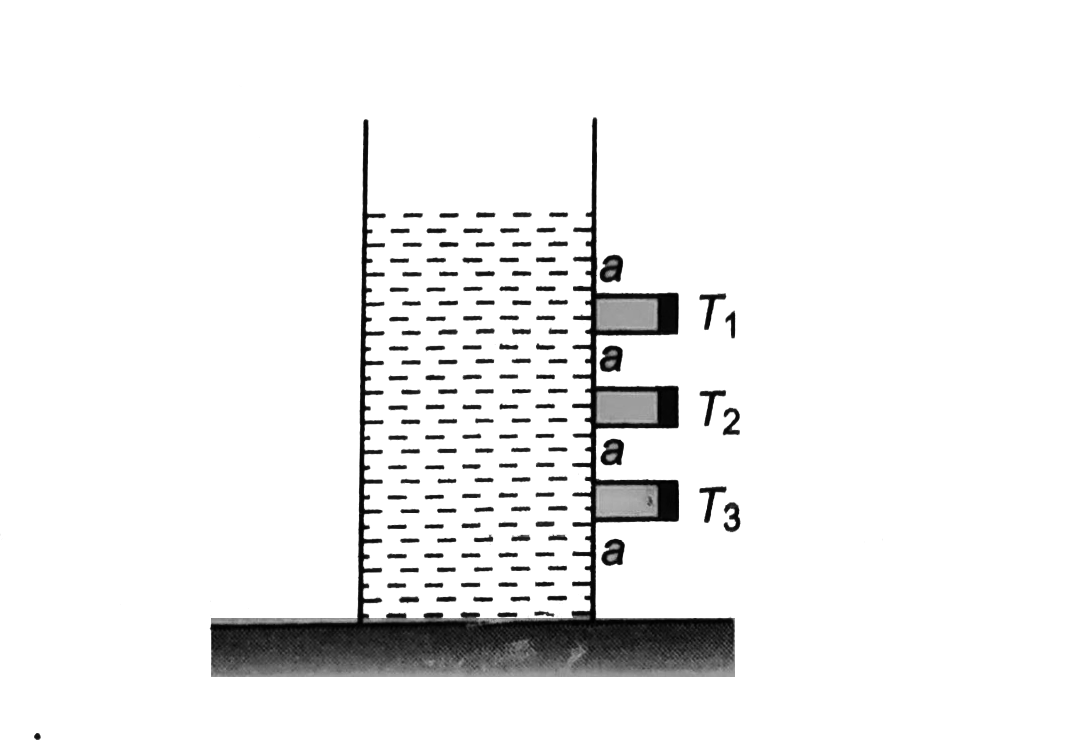
1. speed of efflux is View SolutionQuestion 90
A fully loaded Boeing aircraft has a mass of 3.3×105kg. Its total wing area is 500m2 . It is in level flight with a speed of 960km/h.
(a) Estimate the pressure difference between the lower and upper surfaces of the wings
(b) Estimate the fractional increases in the speed of the air on the upper surfaces of the wing relative to the lower surface. The density of air is 1.2kg/m3.View SolutionQuestion 92
Water is flowing through two horizontal pipes of different diameters which are connected together. In the first pipe the speed of water 4 m/s and the pressure is 2.0×104N/m2. Calculate the speed and pressure of water in the second pipe. The diameter of the pipes the diameter of the pipes are 3 cm and 6 cm respectively. View SolutionQuestion 93
The cross-sectional area of water pipe entering the basement is 4 x 10−4m2. The pressure at this point is 3 x 105Nm−2 and the speed of water is 2 ms−1. This pipe tapers to a cross-sectional area of 2 x 10−4m2 when it reaches the second floor 8 m above. Calculate the speed and pressure at the 2nd floorView SolutionQuestion 94
The pressure difference between two points along a horizontal pipe, through which water is flowing, is 1.4 cm of mercury. If ,due to non-unifrom cross-section, the speed of flow of water at the point of greater cross-section is 60 cm s−1, calculate the speed at the other point .View SolutionQuestion 100
A drum of 30 cm radius has a capacity of 220 dm3 of water. It contains 198dm3 of water and is placed on a solid block of exactly the same size as of drum .If a small hole is made at lower end of drum perpendicular to its length, find the horizontal range of water on the ground in the beginning. Given g = 980 cm s2.View SolutionQuestion 101
The flow of blood in a large artery of an anesthetised dog is diverted through a venturimeter. The wider part of the meter has a cross-sectional area equal to that of the artery, A=16mm2. The narrower part has an area a=9mm2. The pressure drop in the artery is 24 Pa. What is the speed of the blood in the artery ?View SolutionQuestion 102
A horizontal tube has different cross-sectional areas at point A and B .The diameter of A is 4 cm and that of B is 2 cm. Two manometer limbs are attached at A and B. When a liquid of density 8.0 g cm−3 flows through the tube, the pressure difference between the limbs of the manometer is 8 cm. Calculate the rate of flow of the liquid in the tube .View SolutionQuestion 129
A glass tube of 1 mm is dipped vertically into a container of mercury, with its lower end 5 cm below the mercury surface. What must be the gauge pressure of air in the tube to a hemispherical bubble at its lower end? Given density of mercury =13.6×103kg/m3, surface tension of mercury = 440×10−3Nm−1 and g=10m/s2View SolutionQuestion 130
The lower end of a capillary tube of diameter 2.0 mm is dipped 8.00cm below the surface of water in a beaker. What is the pressure required in the tube in order to blow a hemispherical bubble at its end in water? The surface tension of water at temperature of the experiments is 7.30×10−2Nm−1. 1 atmospheric pressure =1.01×105Pa, density of water =1000kg/m3,g=9.80ms−2. also calculate the excess pressure. View SolutionQuestion 136
When a capillary tube of radius r is dipped vertically in a liquid of surface tension T, the liquid rises to a height h in the tube above the level outside the tube . If the angle of contact is θ the density of the liquid is ρ then the pressure difference between the points A and B is
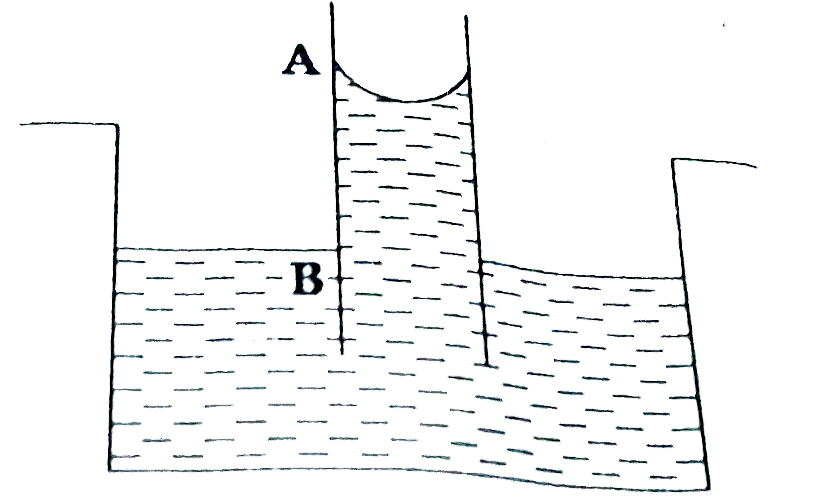 View Solution
View SolutionQuestion 138
Water rises up in a glass capillary upto a height of 9.0cm, while mercury falls down by 3.4cm in the same capillary. Assume angles of contact for water glass and mercury glass 0∘ and 135∘ respectively. Determine the ratio of surface tension of mercury and water (cos135∘=−0.71).View SolutionQuestion 140
If a 5cm long capillary tube with 0.1mm internal diameter, open at both ends, is slightly dipped in water having surface tension 75dyn/cm, state whether:
(i) water will rise halfway in the capillary,
(ii) water will rise up to the upper end of capillary,
(iii) water will overflow out of the upper end of capillary.
Explain your answer. View SolutionQuestion 141
If a 5cm long capillary tube with 0.1mm internal diameter, open at both ends, is slightly dipped in water having surface tension 75dyn/cm, state whether:
(i) water will rise halfway in the capillary,
(ii) water will rise up to the upper end of capillary,
(iii) water will overflow out of the upper end of capillary.
Explain your answer. View SolutionQuestion 143
A glass U-tube is such that the diameter of one limb is 3.0mm and that of the other is 6.0mm. The tube is inverted vertically with the open ends below the surface of water in a beaker. What is the difference between the height to which water rises in the two limbs? Surface tension of water is 0.07Nm−1. Assume that the angle of contact between water and glass is 0∘.View SolutionQuestion 171
In a mercury barometer, at sea level, the normal pressure of the air (one atmosphere) acting on the mercury in the dish supports a 76 cm column of mercury in a closed tube. If you go up in the air, until the density has fallen to half its sea level value, what height of mercury column would you expect?View SolutionQuestion 231
Two cylindrcal vesels placed on a horizontal table contain water and mercury respectively up to the same height. There is a small hole in the walls of each of the vessels at half the height of liquids in the vessels. Find out the ratio of the velocities of efflux of water and mercury from the holes. Whcih of the two jets of liquid will fall at a greater distance on the table from the vessel? Relative density of mercury with respect to water = 13.6View SolutionQuestion 298
A hemispherical portion of radius R is removed from the bottom of a cylinder of radius R. The volume of the remaining cylinder is V and its mass M. It is suspended by a string in a liquid of density ρ where it stays vertical. The upper surface of the cylinder is at a depth h below the liquid surface. The force on the bottom of the cylinder by the liquid is
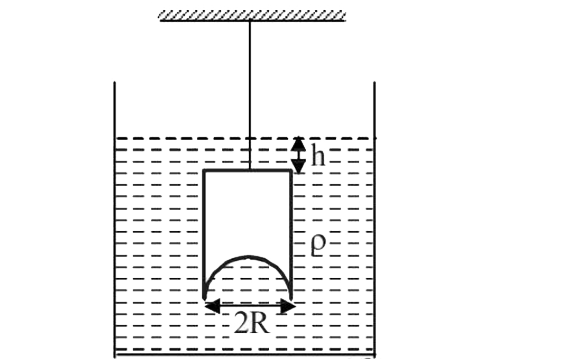 View Solution
View SolutionQuestion 299
A large open tank has two holes in the wall. One is a square hole of side L at a depth y from the top and the other is a circular hole of radius R at a depth 4y from the top. When the tank is completely filled with water, the quantities of water flowing out per second from both holes are the same. Then, R is equal to View SolutionQuestion 302
A metallic sphere of radius 1.0×10−3m and density 1.0×104kg/m3 enters a tank of water, after a free fall through a distance of h in the earth's gravitational field. If its velocity remains unchanged after entering water, determine the value of h. Given: coefficient of viscosity of water =1.0×10−3Ns/m2,g=10ms−2 and density of water =1.0×103kg/m3. View SolutionQuestion 303
Water stands at a depth H in a tank whose side walls are vertical. A hole is made on one of the walls at a depth h below the water surface. Find at what distance from the foot of the wall does the emerging stream of water strike the floor and for what value of h this range is maximum ? What is the maximum possible range ?View SolutionQuestion 304
Water stands at a depth H in a tank whose side walls are vertical. A hole is made on one of the walls at a depth h below the water surface. Find at what distance from the foot of the wall does the emerging stream of water strike the floor and for what value of h this range is maximum ? What is the maximum possible range ?View SolutionQuestion 305
Water stands at a depth H in a tank whose side walls are vertical. A hole is made on one of the walls at a depth h below the water surface. Find at what distance from the foot of the wall does the emerging stream of water strike the floor and for what value of h this range is maximum ? What is the maximum possible range ?View SolutionQuestion 306
A horizontal pipeline carries water in a streamline flow. At a point along the pipe, where the cross- sectional area is 10cm2, the water velocity is 1ms−1 and the pressure is 2000 Pa. The pressure of water at another point where the cross-sectional area is 5cm2, is........Pa. (Density of water =103kg.m−3)View SolutionQuestion 309
Water from a tap emerges vertically downwards with an initial spped of 1.0ms−1. The cross-sectional area of the tap is 10−4m2. Assume that the pressure is constant throughout the stream of water, and that the flow is steady. The cross-sectional area of the stream 0.15 m below the tap isView SolutionQuestion 310
Explain why (a) the blood pressure is humans is greater at the feet than at the brain.
(b) Atmospheric pressure at a height of about 6 km decreases to nearly half its value at the sea level through the 'height' of the atmospheric is more than 100 km.
(c) Hydrostatic pressure is a scalar quantity even though pressure is force divided by area , and force is a vector. View SolutionQuestion 311
Explain why (a) the blood pressure is humans is greater at the feet than at the brain.
(b) Atmospheric pressure at a height of about 6 km decreases to nearly half its value at the sea level through the 'height' of the atmospheric is more than 100 km.
(c) Hydrostatic pressure is a scalar quantity even though pressure is force divided by area , and force is a vector. View SolutionQuestion 312
Explain why (a) the blood pressure is humans is greater at the feet than at the brain.
(b) Atmospheric pressure at a height of about 6 km decreases to nearly half its value at the sea level through the 'height' of the atmospheric is more than 100 km.
(c) Hydrostatic pressure is a scalar quantity even though pressure is force divided by area , and force is a vector. View SolutionQuestion 313
Explain why
(a). The angle of contact of mercury with galss is obtuse, while that of water with glass is acute.
(b). Water on a clean glass surface tends to spread out while mercury on the same surface tends to form drops. (Put differently, water wets glass while mercury does not).
(c). Surface tension of a liquid is independent of the area of the surface
(d). Water with detergent disolved in it should have small angles of contact.
(e). A drop of liquid under no external forces is always spherical in shape.View SolutionQuestion 314
Explain why
(a). The angle of contact of mercury with galss is obtuse, while that of water with glass is acute.
(b). Water on a clean glass surface tends to spread out while mercury on the same surface tends to form drops. (Put differently, water wets glass while mercury does not).
(c). Surface tension of a liquid is independent of the area of the surface
(d). Water with detergent disolved in it should have small angles of contact.
(e). A drop of liquid under no external forces is always spherical in shape.View SolutionQuestion 316
Explain why
(a). The angle of contact of mercury with galss is obtuse, while that of water with glass is acute.
(b). Water on a clean glass surface tends to spread out while mercury on the same surface tends to form drops. (Put differently, water wets glass while mercury does not).
(c). Surface tension of a liquid is independent of the area of the surface
(d). Water with detergent disolved in it should have small angles of contact.
(e). A drop of liquid under no external forces is always spherical in shape.View SolutionQuestion 317
Explain why
(a). The angle of contact of mercury with galss is obtuse, while that of water with glass is acute.
(b). Water on a clean glass surface tends to spread out while mercury on the same surface tends to form drops. (Put differently, water wets glass while mercury does not).
(c). Surface tension of a liquid is independent of the area of the surface
(d). Water with detergent disolved in it should have small angles of contact.
(e). A drop of liquid under no external forces is always spherical in shape.View SolutionQuestion 320
Find in the blanks using the word (s) from the test appended with each statement.
(a) Surface tension of liquid generally …..with temperatures (increase//decreases).
(b) Viscosity of gases ….. With temperature, whereas viscosity of liquids ……with temperature. (increases//decreases)/
(c) For solids with elastic modulus of rigidity, the shearing force is proportional to .....while for fluids it is proportional to ....(shear strain//rate of shear strain).
(d) For a fluid in a steady flow, from .....(conservation of mass// Bernoulli's principle)
(e ) For the model of a plane in a wind tunnel, turbulence oc curs at a ...... speed for turbulence for an actual plane (greater//smaller)/View SolutionQuestion 322
Find in the blanks using the word (s) from the test appended with each statement.
(a) Surface tension of liquid generally …..with temperatures (increase//decreases).
(b) Viscosity of gases ….. With temperature, whereas viscosity of liquids ……with temperature. (increases//decreases)/
(c) For solids with elastic modulus of rigidity, the shearing force is proportional to .....while for fluids it is proportional to ....(shear strain//rate of shear strain).
(d) For a fluid in a steady flow, from .....(conservation of mass// Bernoulli's principle)
(e ) For the model of a plane in a wind tunnel, turbulence oc curs at a ...... speed for turbulence for an actual plane (greater//smaller)/View SolutionQuestion 323
Explain why
(a). To keep a piece of paper horizontal, you should blow over, not under, it
(b). When w try to close a water tap with our fingers, fast jets of water gush through the openings between our fingers
(c). The size of the needle of a syringe controls flow rate better than the thumb pressure exerted by a doctor while administering an injection
(d). A fluid flowing out of a small hole in a vessel results in a backward thrust on the vessel
(e). A spinning cricket ball in air does not follow a parabolic trajectory.View SolutionQuestion 324
Explain why
(a). To keep a piece of paper horizontal, you should blow over, not under, it
(b). When w try to close a water tap with our fingers, fast jets of water gush through the openings between our fingers
(c). The size of the needle of a syringe controls flow rate better than the thumb pressure exerted by a doctor while administering an injection
(d). A fluid flowing out of a small hole in a vessel results in a backward thrust on the vessel
(e). A spinning cricket ball in air does not follow a parabolic trajectory.View SolutionQuestion 326
Explain why
(a). To keep a piece of paper horizontal, you should blow over, not under, it
(b). When w try to close a water tap with our fingers, fast jets of water gush through the openings between our fingers
(c). The size of the needle of a syringe controls flow rate better than the thumb pressure exerted by a doctor while administering an injection
(d). A fluid flowing out of a small hole in a vessel results in a backward thrust on the vessel
(e). A spinning cricket ball in air does not follow a parabolic trajectory.View SolutionQuestion 327
Explain why
(a). To keep a piece of paper horizontal, you should blow over, not under, it
(b). When w try to close a water tap with our fingers, fast jets of water gush through the openings between our fingers
(c). The size of the needle of a syringe controls flow rate better than the thumb pressure exerted by a doctor while administering an injection
(d). A fluid flowing out of a small hole in a vessel results in a backward thrust on the vessel
(e). A spinning cricket ball in air does not follow a parabolic trajectory.View SolutionQuestion 335
Glycerine flows steadily through a horizontal tube of length 1.5m and radius 1.0 cm. if the amount of glycerine collected per second at one end is 4.0×10−3kgs−1, what is the pressuer difference between the two ends of the tube? (density of glycerine = 1.3×103kgm−3 and viscosity of glycerine =0.83Nsm−2).View SolutionQuestion 340
What is the excess pressure inside a bubble of soap solution of radius 5.00mm, given that the surface tension of soap solution at the temperature (20∘C) is 2.50×10−2Nm−1? If an air bubble of the same dimension were formed at a depth of 40.0 cm inside a container containing the soap solution (of relative density 1.20), what would be the pressure inside the bubble? (1atm. is 1.01×105Pa).View SolutionQuestion 341
A tank with a square base of area 1.0m2 is divided by a vertical parition in the middle. The bottom of the partition has a small hinged door of area 20cm2. The tank is filled with water and an acid (of relative density 1.7) in the other, both to a height of 4.0m. Compute to force necessary the force nec cessary to keep the door closed.View SolutionQuestion 342
A manometer reads the pressure of a gas in a enclosure as shown in figure(a) When some of the gas is removed by a pump, the manometer reads as in (b). The liquid used in the manometers is mercury and the atmospheric pressure is 76cm of mercury.
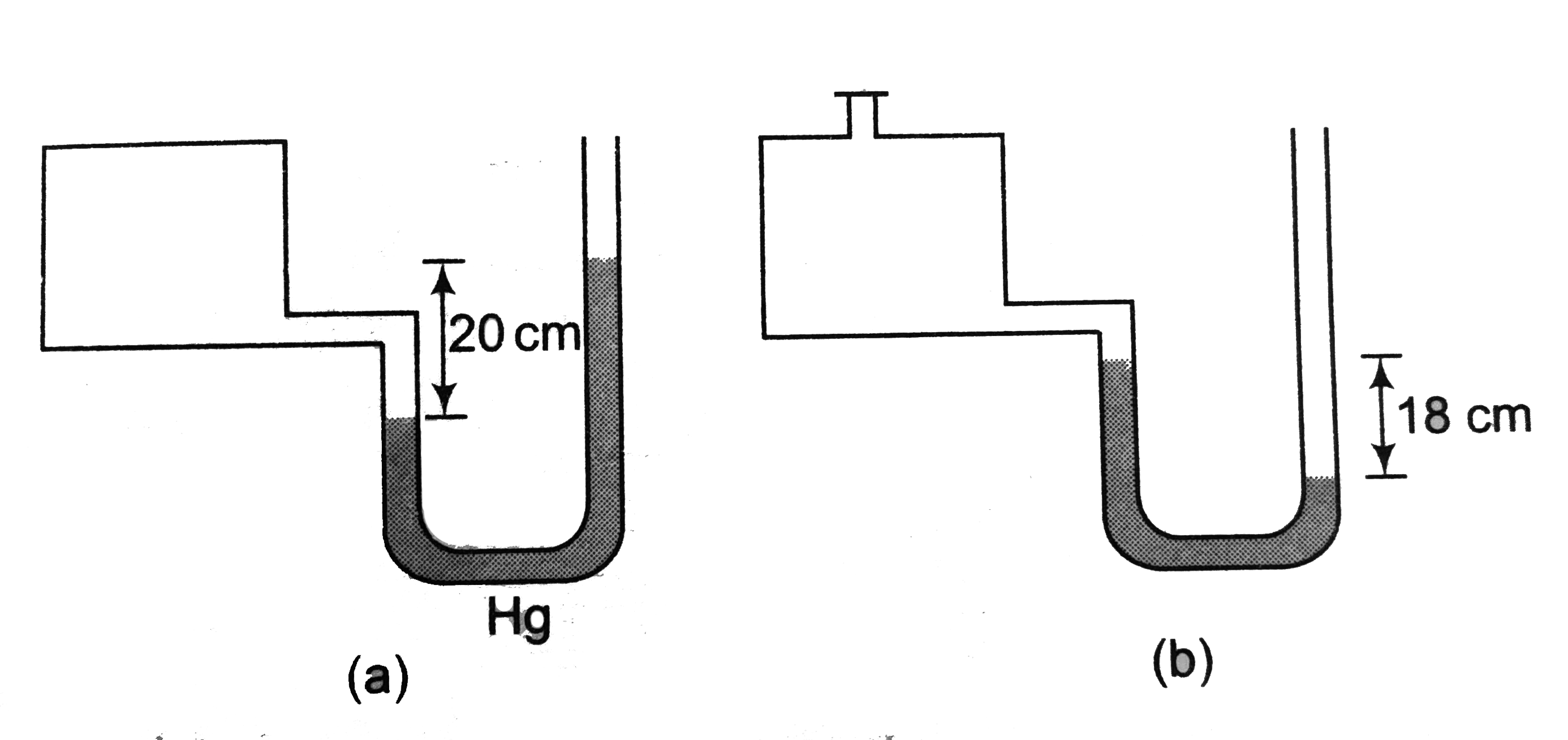
(i) Give the absolute and gauge pressure of the gas in the enclosure for cases (a) and (b) in units of cm of mercury .
(ii) How would the level change in case (b) if 13.6cm of water are poured into the right limb of the manometer?View SolutionQuestion 343
A manometer reads the pressure of a gas in a enclosure as shown in figure(a) When some of the gas is removed by a pump, the manometer reads as in (b). The liquid used in the manometers is mercury and the atmospheric pressure is 76cm of mercury.

(i) Give the absolute and gauge pressure of the gas in the enclosure for cases (a) and (b) in units of cm of mercury .
(ii) How would the level change in case (b) if 13.6cm of water are poured into the right limb of the manometer?View SolutionQuestion 344
Two vessels have the same base area but differnent shapes. The first vessel takes twice the vloume of water that the second vessel requires to fill up to a paricular common height . Is the force exerted by water on the base of the vessel the same in the two case? If so, why do the vessels filled with water to that same height give different reading on a weighting scale ?View SolutionQuestion 345
Two vessels have the same base area but differnent shapes. The first vessel takes twice the vloume of water that the second vessel requires to fill up to a paricular common height . Is the force exerted by water on the base of the vessel the same in the two case? If so, why do the vessels filled with water to that same height give different reading on a weighting scale ?View SolutionQuestion 347
In deriving Bernoulli's equation , we equated the workdone on the fluid in the tube to its change in the potential and kinetic energy (a) How does the pressure change as the fluid moves along the tube if dissipative forces are present ? (b) Do the dissipative forces becomes more important as the fluid velocity increase? Discuss qualitatively. View SolutionQuestion 348
In deriving Bernoulli's equation , we equated the workdone on the fluid in the tube to its change in the potential and kinetic energy (a) How does the pressure change as the fluid moves along the tube if dissipative forces are present ? (b) Do the dissipative forces becomes more important as the fluid velocity increase? Discuss qualitatively. View SolutionQuestion 352
In Millikan's oil drop experiment, what is the terminal speed of a speed of a drop of radius 2.0×105m and density 1.2×103m−3? Take the viscosity of air at the temperature of the experimental to be 1.8×10−5Nsm2. How much is the viscous force on the drop at that speed? Neglect buoyancy of the drop due to air. View SolutionQuestion 353
Mercury has an angle of contact equal to 140∘ with soda lime galss. A narrow tube of radius 1.00mm made of this glass is dipped in a through containing mercury. By what amount does the mercury dip down in the tube relative to the mercury surface outside? Surface tension of mercury at the temperature of the experiment is 0.465Nm−1. Density of mercury = 13.6×103kgm−3.View SolutionQuestion 354
Two narrow bores of diameters 3.0mm and 6.0 mm are joined together to form a U-shaped tube open at both ends. If th U-tube contains water, what is the difference in its levels in the two limbs of the tube? Surface tension of water at the temperature of the experiment is 7.3×10−2Nm−1. Take the angle of contact to be zero. and density of water to be 1.0×103kg/m3.
(g=9.8ms−2)View SolutionQuestion 355
(a). It is known that density ρ of air decreases with height y as
ρ=ρ0e−y/y(_o) ltb rgt where po=1.25kgm−3 is the density at sea level, and yo is a constant. This density variation is called the law of atmospheres. Obtain this law assuming that the temperature of atmosphere remains a constant (isothermal conditions). Also assume that the value of g remains constant
(b). A large He balloon of volume 1425m3 is used to lift a payload of 400 kg. Assume that the balloon maintains constant radius as it rises. How high does it rise?
[take yo=8000mandρHe=0.18kgm−3]View Solution

